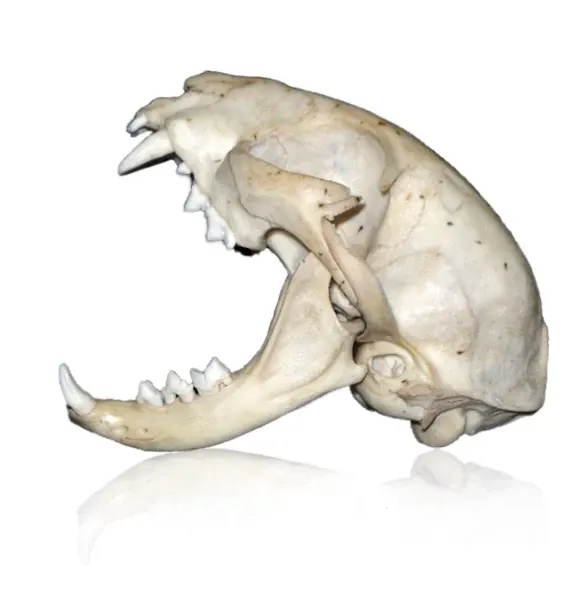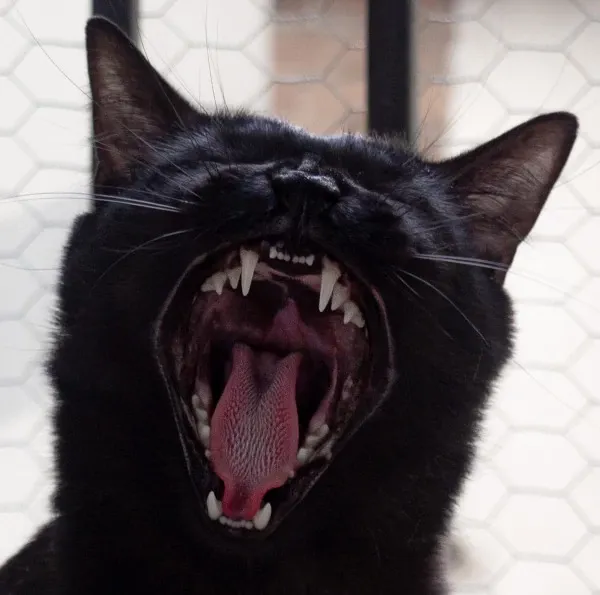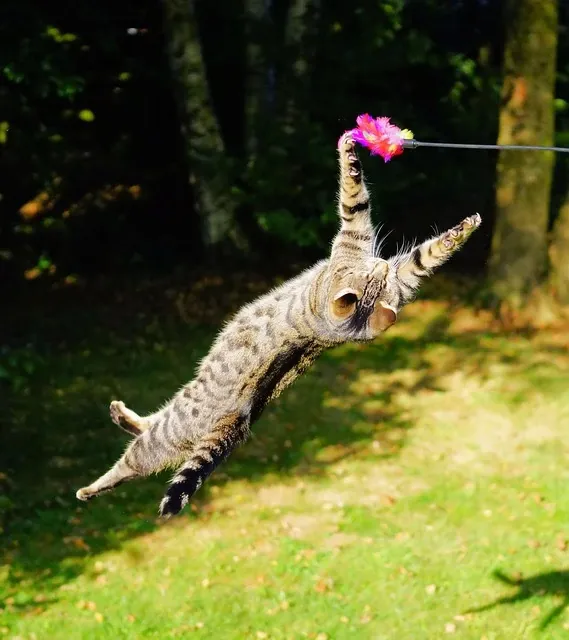Where's the Proof that House Cats are Strict Carnivores?
House cats are classified as obligate or hyper carnivores, a group of strict meat eaters. Millennia of domestication did not erase a single one of their carnivore characteristics. Clear proof of their status as hyper carnivores remain locked up in their genes, physiology, anatomy and behaviour.

A previous post – Are House Cats Still Carnivores? – delved into whether or not house cats are to be seen as true carnivores. This post revealed that the house cat belongs to the order Carnivora Felidae, a group of strict meat eaters.
Now, let us consider the facts behind this classification.
Genetic proof
The post Meet the Wild Ancestors of the House Cat revealed the house cat's close genetic ancestry to Felis silvestris, a small group of true wildcat.
This post identified the common house cat's remarkable genetic similarities to Felis sylvestris lybica – the African/Near Eastern wildcat – and Felis sylvestris cafra – the southern African wildcat.
...the house cat’s genetics remains unchanged
The above two subspecies of wildcat are seen as the closest progenitors of the house cat 1.
Today’s house cat is biologically and genetically still virtually identical to these two small wildcat species 1.
Incomplete domestication
Feline geneticist, Dr Carlos Driscoll, states it well. Modern house cats are the product of 11 million years of natural selection in a world that was free from human influence 2.
Therefore, the 10 000 1 or 12 000 3 years spent alongside humans did nothing to change cats. In evolutionary terms, it is the mere blink of an eye and simply not enough time to produce any significant genetic differences 1.
...co-existence rather than domestication
During the cat's long affiliation with humans, they were coveted for their hunting abilities to control rodents that threatened human food supplies. This led to a symbiotic relationship rather than domestication.
Therefore, cats co-existed alongside humans instead of becoming dependent on them for food.
...cats merely seized an opportunity
The abundance of rodents and other vermin that came with civilisation was the deciding factor. Rats and mice were lured by granaries, food reserves and waste created by human settlements.
Small wildcat species in the vicinity merely took advantage of this abundant and steady food source 1.
...cats were kept wild and keen
Humans fully realised the importance of not feeding healthy cats. They needed to be kept sharp and hungry so they would continue to hunt and control vermin.
Dr Carlos Driscoll and his team assert that true domestication happened less than 200 years ago, and in a very incomplete fashion 2.
…’domestication’ is a very recent concept
In the years leading up to the 19th century, cats continued to hunt in and around human settlements. This led to their separation from their wildcat ancestors and their classification as the subspecies Felis sylvestris catus 1.
By the mid 19th century, cats were fed the occasional table scrap 4, but they continued to rely predominantly on hunting.
…domestication remains incomplete
Forming a companionship with cats and feeding them a man-made, commercial diet is a very recent tendency 2. Even now, in the 21st century, where house cat's are fed this artificial diet, they will still hunt – whenever given the opportunity.
Cats might have modified certain behaviours to live alongside humans in more recent years, but biologically they remain obligate carnivores like their wildcat natives 2.
Physiological proof
Notably, not a single cat species on earth has evolved to eat anything other than animal tissue. All cats – from the smallest to the largest species – are metabolically dependent solely upon prey animals for all their energy and nutritional needs 5. This extends to the house cat too.
House cats are incredibly cool. Their physiology is quite remarkable and distinctive. They possess a whole host of interesting physiological adaptations and nutrient requirements, true to their obligate carnivore roots.
…unique biological adaptations
The majority of the adaptations seen in the cat's biology are quite unique and are not often seen in other mammalians, or even most other carnivores.
Are House Cats Still Carnivores? revealed that all cats belong to the family Felidae. This class of felids is one of only a few mammalians that are hyper carnivores, meaning that they consume nothing but animal tissues.
…no less than 14 major adaptations to carnivory
The next blog post The Cat’s Unique Physiological Adaptations to Carnivory showcases the 14 most prominent of these adaptations. This blog post brings all of the proof of the house cat’s super carnivore status full circle.
The house cat's adaptations are quite interesting and range from their taste buds and liver enzymes, to their rather odd inability to produce vitamin D from sun exposure. Be sure to look at this post – cats really rock at being carnivores!

Anatomical proof
For one, the caecum – the part of the large intestine responsible for digesting plant matter – is largely absent in felids 6. Therefore, they lack the ability to effectively digest plant matter.
But their most impressive anatomical feature is probably their very distinctive hunting apparatus.
Sharp claws and specialised dentition are used to hunt. The dental adaptations are so interesting that they definitely deserve additional attention:
…unique dentition
True to their carnivorous heritage, the cat's teeth are dominated by large canines that are used to sever the neck vertebrae of prey animals 7.
Ethologist, Paul Leyhausen, explains that a cat's canine teeth fit precisely between the vertebrae of prey, almost like a key will fit a lock 8.
Characteristic carnassials, that move against each other in a scissor action, shear flesh from bone and dissect prey carcasses into edible portions 7.
In addition, the hinges of a cat's jaw do not have the ability for the lateral chewing or grinding motion associated with plant-eating species 9.

Cats also have comparatively small incisors and molars which further indicate their inability to effectively masticate plant matter. These anatomical features provide proof, beyond any contention, that house cats are sophisticated carnivores.
When closely inspecting a house cat's dentition, it becomes evident that those pearly whites are meant for killing, slicing and shearing.
Behavioural proof
When engaging in play with cats, their hunting tendencies quickly emerge. They stalk, pounce and ‘subdue’ their toys. Their agility and lightning speed are beautifully showcased during these moments of play.
And cats love to participate in games that emulate hunting as these forms of play elicit primordial, instinctual behaviour.

Even today, house cats will hunt at every given opportunity. If a cat is abandoned – which unfortunately happens all too often – they will most likely become strays, scavenging and living on garbage 10.
If stray cats manage to survive long enough and if conditions are in their favour, they might eventually turn feral and return to their roots as hunters, driven by hunger and survival instinct.
…misplaced little hunters
Even indoor cats that spend very little time outdoors will hunt at the first opportunity. Unfortunately, very inexperienced indoor cats mostly do not posses the repertoire of 'follow through' behaviour and often just injure or maim a prey animal.
In spite of cats instinctually giving chase and catching prey animals, what happens thereafter is learnt behaviour. They therefore lack the training to effectively kill, dissect and eat a prey animal.
This disconnect between programmed and subsequent behaviour is brought about by a gap in the modern house cat's education.
While their instinctual hunting behaviour is easily evoked, they have not been taught by their mothers what to do after the prey has been caught and subdued.
They might not even realise that what they have in their claws is actually food. That explains why some city slickers end up playing with freshly caught prey. Strange but true.
…as obligate carnivores, what should cats really be eating?
To feed cats a diet of commercial, ultra processed foods, has become second nature to us. However, it is only logical that the house cat’s status as hyper carnivores should really be the guiding principle of what we feed them.
A later post What Should House Cats Eat? And Why? provides an overview of what cats should be eating and why. In the same vein, it considers what a biologically and species appropriate diet looks like.


References
1 Driscoll, C.A., Menotti-Raymond, M., Roca, A.L., Hupe, K., Johnson, W.E., Geffen, E., Harley, E.H., Delibes, M., Pontier, D., Kitchener, A.C., Yamaguchi, N., O’Brien, S.J. & Macdonald, D.W., (2007). The Near Eastern origin of cat domestication. Science, 317, 519 – 523.
2 Driscoll, C.A., Macdonald, D.W., &O'Brien, S.J. (2009). From wild animals to domesticated pets, an evolutionary view of domestication. Proceedingsof the National Academy of Sciences106(Suppl 1), 9971 – 9978.
3 Callaway, E. (2016). How cats conquered the world (and a few Viking ships). In Nature. Retrieved September 27, 2016, from https://www.nature.com/articles/nature.2016.20643
4 Crane, S.W., Cowell, C.S., Stout, N.P., Moser, E.A., Millican, J., Romano, P. & Crane, S.E. (2010). History of Pet Food Manufacture. In S.H. Hand, C.D. Thatcher, R.L. Remillard, P. Roudebush & B.J. Novotny (Eds) (2010). Small Animal Clinical Nutrition, 5th ed. (p. 158). Topeka, Kansas: Mark Morris Institute.
5 Bradshaw, J.W.S., Goodwin, D., Legrand-Defrétin, V. & Nott, H.M.R. (1996). Food selection by the domestic cat, an obligate carnivore. Comparative Biochemistry and Physiology Part A: Physiology 114(3), 205 – 209.
6 Yarnall, C. & Hofve, J. (2009). The complete guide to holistic cat care: an illustrated handbook. Beverly, Massachusetts: Quarry Books.
7 Bradshaw, J.W.S. (2006). The Evolutionary Basis for the Feeding Behavior of Domestic Dogs (Canis familiaris) and Cats (Felis catus). The Journal of Nutrition, 136(7), 1927S – 1931S.
8 Sunquist, M. E. & Sunquist, F. (2002). Wild cats of the world: The ultimate reference to every species worldwide. Chicago: University of Chicago Press.
9 Griffiths, S. & Ruish, D. (n.d.). Evolutionary nutrition for the cat. In Club Canine. Online booklet retrieved April 29, 2015. Shortened/revised version available from http://www.clubcanine.net/ evolutionary-nutrition-cats.shtml
10 Spotte, S. (2014). Free ranging cats: Behavior, ecology, management. Chichester, West Sussex: Wiley-Blackwell.
Disclaimer
The information provided on the Bestfedcats.com website is educational and informational. We are here to give guidance on how to feed a properly balanced raw diet. We also offer advice on how to improve the diet of the modern house cat. Please note that we are not veterinarians. We are not here to give veterinary advice. Best Fed Cats will not be held responsible for any adverse reactions to your cat based on the information on our website. The health of your cat depends entirely on you. We expect you to use your knowledge of your cats, their circumstances and their health – in conjunction with a trusted veterinarian – to determine if any advice provided on this site is appropriate for your cats.

